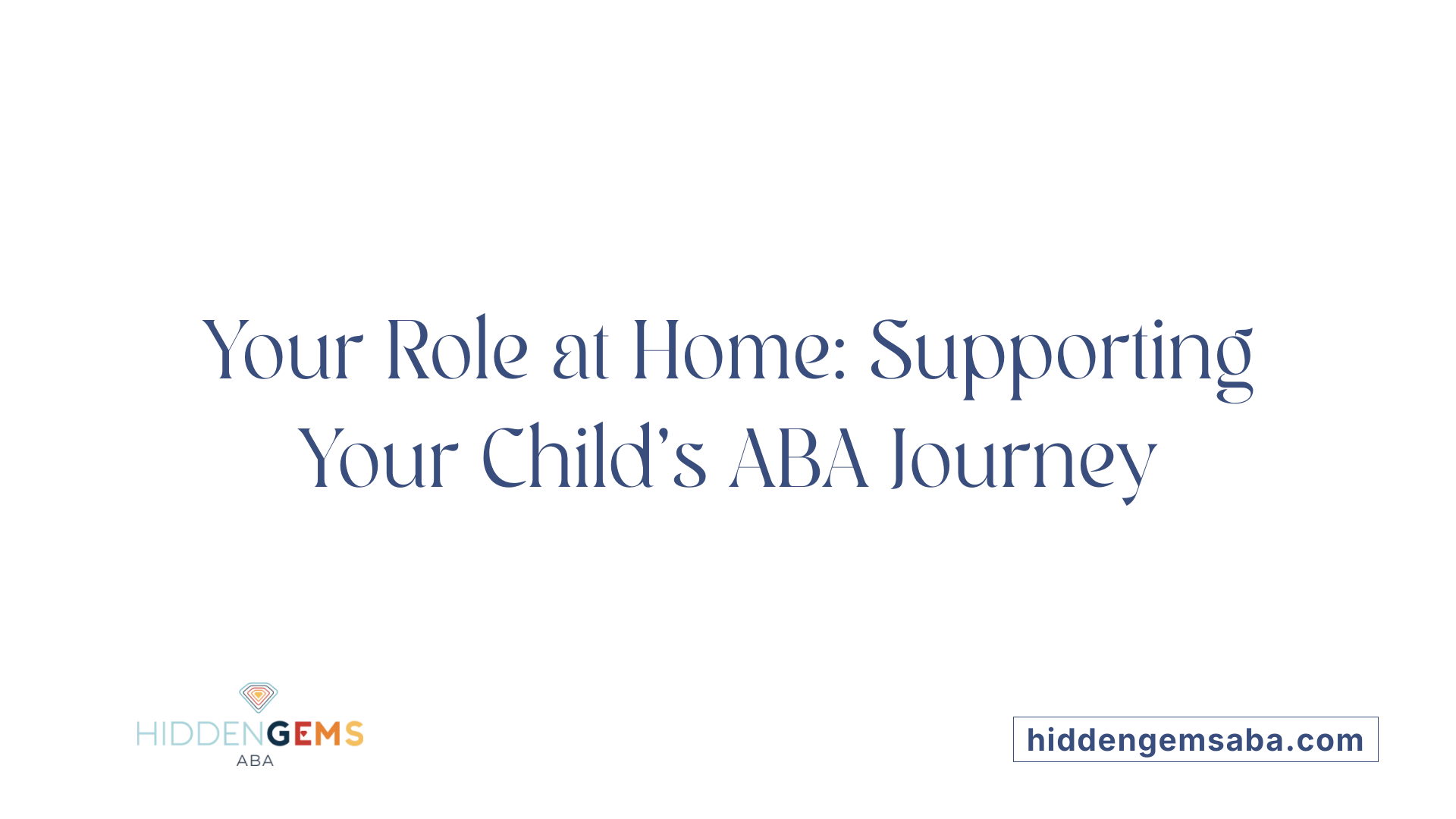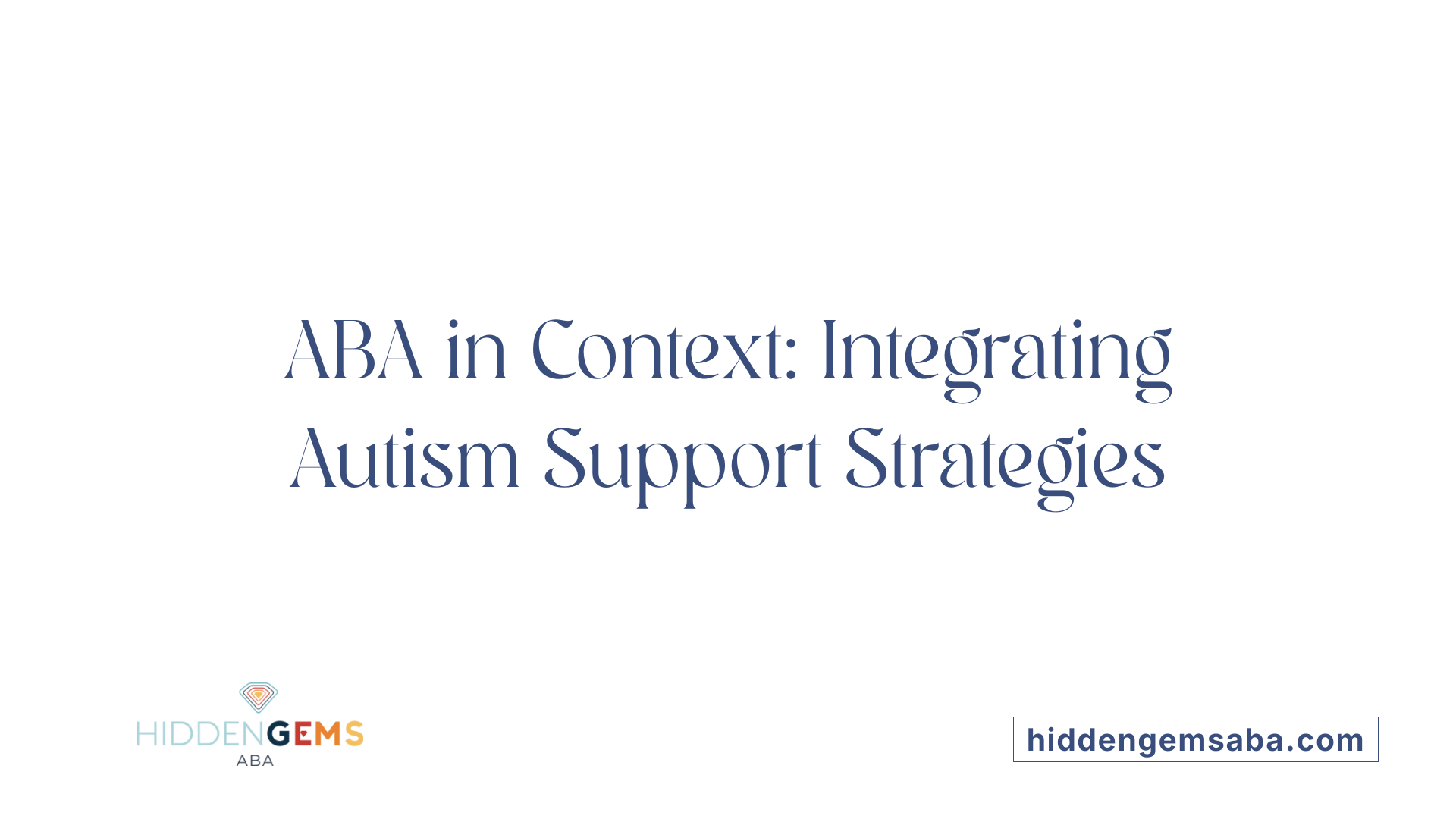Understanding the Science Behind Autism Treatment
Applied Behavior Analysis (ABA) therapy stands as a cornerstone in the treatment of autism spectrum disorder, combining rigorous scientific principles with personalized care strategies. This article explores the foundations of ABA therapy, the specialized professionals who deliver it, and its transformative impact on individuals with autism, offering insight for families considering this evidence-based approach.
What is Applied Behavior Analysis (ABA) Therapy?

Definition of ABA Therapy
Applied Behavior Analysis (ABA) therapy is a science-based approach focused on understanding and improving behavior. It uses the principles of learning and behavior analysis to increase helpful behaviors and decrease harmful or impeding ones, especially in individuals with autism spectrum disorder (ASD).
Scientific Basis of ABA
ABA is grounded in the science of learning and behavior. It employs the ABC model — Antecedent, Behavior, Consequence — to analyze and modify behavior. This model helps identify what triggers a behavior, the behavior itself, and the consequences that influence whether the behavior will be repeated.
ABA's Goals in Behavior Modification
ABA therapy aims to promote positive behaviors such as improved communication, social skills, attention, and academic abilities while reducing problematic behaviors. It focuses on teaching functional skills and supports meaningful development.
Individualization of ABA Programs
Each ABA program is tailored to the individual's unique skills, needs, interests, and family situation. A Board Certified Behavior Analyst (BCBA) conducts assessments and develops personalized treatment plans. The therapy can be delivered across settings such as home, school, and community, supporting flexibility and relevance.
Common ABA Methodologies
Several specific methodologies are commonly used in ABA interventions:
- Discrete Trial Training (DTT): Breaks skills into small, teachable steps.
- Pivotal Response Treatment (PRT): Focuses on pivotal skills like motivation and communication initiation.
- Early Start Denver Model (ESDM): Combines ABA principles with developmental approaches for young children. These methods use prompting, reinforcement, and repeated practice to encourage skill acquisition.
Evidence Supporting ABA Effectiveness
Research extensively supports ABA as an effective, evidence-based intervention for autism. When provided intensively (typically 25–40 hours per week) over 1–3 years, ABA leads to significant improvements in socialization, communication, and language. It is widely recognized by health authorities and covered by some insurance plans, including Medicaid for eligible children.
| Aspect | Description | Example/Application |
|---|---|---|
| Scientific Basis | Uses learning principles and ABC model | Identifying triggers for behavior and using positive reinforcement |
| Behavior Goals | Increase helpful, decrease harmful behaviors | Teaching communication skills while reducing tantrums |
| Individualization | Customized to individual needs and settings | Home-based sessions tailored to family routines |
| Methodologies | DTT, PRT, ESDM approaches | Teaching with structured trials or naturalistic play |
| Evidence | Supported by research and health organizations | Intensive early intervention improving developmental outcomes |
The Professionals Behind ABA Therapy: Qualifications and Roles

Who provides ABA therapy and what qualifications do they have?
ABA therapy is delivered by skilled professionals primarily including Board Certified Behavior Analysts (BCBAs) and Registered Behavior Technicians (RBTs). BCBAs are experts with advanced degrees in behavior analysis or related fields. They undergo extensive training that involves rigorous coursework, supervised clinical experience, and a certification exam. This training equips them to design, oversee, and adjust individualized behavior intervention programs tailored to each client's unique abilities and needs.
RBTs provide direct therapy under the guidance of BCBAs. Though they do not hold advanced degrees, RBTs complete a specific training program and competency assessment to ensure they can properly implement ABA strategies such as positive reinforcement and applying the Antecedent-Behavior-Consequence (ABC) model. Their role is crucial in delivering day-to-day therapy sessions effectively.
Supervision is a fundamental component of ABA programs. BCBAs continuously monitor RBTs and the therapy’s progress, making necessary adjustments to treatment plans. This ensures the therapy remains ethical and based on evidence-supported strategies, maximizing outcomes for individuals.
These professionals prioritize ethical standards by adhering to guidelines from behavior analysis certifying bodies. They emphasize positive reinforcement techniques, individualization of therapy, and ongoing measurement of progress. This structured, expert-led approach has been shown to yield significant improvements in social skills, communication, and adaptive behaviors for those receiving ABA therapy.
How ABA Therapy Empowers Individuals with Autism
How does ABA therapy help individuals with autism?
ABA therapy supports individuals with autism by focusing on increasing positive behaviors such as communication and social skills while reducing problematic behaviors that may hinder daily functioning. This approach is deeply personalized and evidence-based, ensuring that each program is tailored to the unique needs, abilities, and interests of the individual.
Improvement in communication, social skills, and independence
ABA therapy enhances essential skills like language, communication, attention, and social interaction through various techniques including discrete trial training (DTT) and pivotal response treatment (PRT). These methods encourage functional communication and social engagement, fostering greater independence in everyday settings.
Reduction of problematic behaviors
Through consistent use of positive reinforcement and the ABC (Antecedent, Behavior, Consequence) model, ABA therapists systematically identify and reduce behaviors that interfere with learning and social integration. This method promotes desirable behaviors by rewarding them, which increases their frequency over time.
Personalized and evidence-based approaches
Every ABA program is carefully designed by Board Certified Behavior Analysts (BCBAs), who develop treatment plans focusing on specific goals in areas such as self-care, motor skills, play, and academics. The therapy incorporates ongoing assessment to measure progress and adapt strategies, ensuring that treatment remains effective and relevant.
Early intervention benefits
When ABA therapy is provided intensively—typically 25 to 40 hours per week—during the first years of life, it can lead to substantial developmental improvements. Early intervention with ABA has been shown to reduce the need for special education services later and facilitate integration into mainstream educational environments.
Functional skill development
Beyond communication and social skills, ABA also targets self-care abilities such as dressing and eating, which support greater autonomy. Therapists often collaborate with family members to implement strategies within home, school, and community settings, reinforcing learned skills across everyday situations.
Integration into mainstream settings
Successful ABA therapy can enable children with autism to participate more fully in typical school environments and community activities. By building a broad range of skills and lowering barriers caused by behavioral challenges, ABA helps individuals achieve meaningful inclusion and improved quality of life.
In summary, ABA therapy empowers people with autism by delivering a structured, scientifically supported, and adaptable approach that encourages positive development and independence while managing behaviors that could interfere with growth and learning.
Techniques and Strategies Utilized in ABA Therapy

What are the common techniques used in ABA therapy?
ABA therapy employs a variety of techniques designed to build skills and reduce challenging behaviors through systematic and individualized approaches.
One widely used method is Discrete Trial Training (DTT), which involves breaking down skills into small, structured steps practiced through repetitive trials. Each trial has a clear beginning and end, with positive reinforcement given for correct responses.
Pivotal Response Treatment (PRT) takes a more naturalistic approach, targeting pivotal areas such as motivation and self-initiation to encourage broader improvements across multiple behaviors. This technique integrates learning into play and everyday activities.
Similarly, Natural Environment Teaching (NET) focuses on using real-life situations as opportunities for learning, promoting spontaneous communication and problem-solving skills.
To support skill acquisition, ABA uses prompting and fading strategies. Prompts guide the individual toward the correct response, and over time, these prompts are gradually reduced (faded) to encourage independence.
Complex tasks are taught through behavior chaining and task analysis, where a behavior is broken down into smaller components. For example, a multi-step activity like handwashing is divided into manageable steps taught sequentially until the full skill is mastered.
At the core of ABA is the use of reinforcement methods. Positive reinforcement rewards desired behaviors immediately, increasing the likelihood they will recur. Negative reinforcement and extinction are also sometimes used to discourage undesired behaviors.
ABA programs often incorporate visual aids and modeling to support learning. Visual supports help clarify expectations and routines, while modeling involves demonstrating behaviors for the individual to imitate.
These techniques work together cohesively to make ABA therapy adaptable and effective, tailored to the individual’s unique needs and learning style.
Supporting ABA Therapy at Home: The Role of Parents and Caregivers

How can parents and caregivers support ABA therapy at home?
Parents and caregivers play a crucial role in enhancing the effectiveness of ABA therapy by actively participating and receiving training in ABA techniques. This involvement allows them to apply consistent behavioral strategies, ensuring that the child experiences uniform expectations and reinforcement at home, which is essential for sustained progress.
Consistency across environments is vital. When the same principles, such as positive reinforcement, are used both at home and in therapy sessions, children are more likely to generalize their skills and maintain improvements across different settings.
Collaboration with therapists
A strong partnership between families and ABA therapists fosters open communication regarding the child’s progress and any challenges faced. This collaboration supports the adaptation of strategies that align with the child’s evolving needs and family circumstances.
Creating supportive home routines
Establishing predictable and structured home routines encourages independence and positive behaviors. Parents can integrate learned skills into daily activities, making practice a natural part of the child's day.
Generalization of skills and family-centered goal setting
Practicing skills across varied contexts helps children transfer their abilities from the therapeutic environment to everyday life. Moreover, involving the family in setting clear, achievable goals ensures that therapy aligns with their priorities and supports holistic development.
By engaging actively, maintaining consistency, working closely with therapists, and fostering supportive routines, parents and caregivers become instrumental in maximizing the benefits of ABA therapy at home.
ABA Therapy in the Broader Context of Autism Interventions

How does ABA therapy compare to other behavioral and developmental treatments?
ABA stands as the most evidence-supported behavioral approach for autism spectrum disorder (ASD), emphasizing increasing positive and decreasing negative behaviors using methods like Discrete Trial Training (DTT) and Pivotal Response Treatment (PRT). In contrast, developmental strategies focus more precisely on skill-building — such as language development through speech therapy — while educational methods like TEACCH provide structured environments and visual supports tailored to ASD learning styles. Social-relational approaches target emotional connections and social skills through interventions like DIR/Floor Time and Social Stories.
What role does ABA play in managing core autism symptoms and related challenges?
ABA primarily addresses core ASD symptoms by promoting socialization, communication, and language skills. Studies show that intensive ABA (20+ hours weekly) in early childhood leads to significant developmental gains and less reliance on special services later. While ABA does not treat co-occurring conditions directly, it is complemented by psychological therapies, like cognitive-behavior therapy (CBT), to manage associated anxiety or depression.
How does ABA integrate with occupational and speech therapies?
ABA programs can be adapted to individual needs and often coordinate with occupational therapy, which teaches daily living skills and may include sensory integration or physical therapy. Similarly, speech therapy dovetails with ABA by enhancing functional communication through prompting and reinforcement within the ABA framework.
What is the role of medications and complementary approaches alongside ABA?
There are no medications targeting ASD core symptoms, but drugs may alleviate additional challenges such as hyperactivity or sleep disturbances. Complementary treatments—like mindfulness, animal therapy, or dietary interventions—are sometimes used alongside traditional therapies, although these should always be discussed with healthcare providers to ensure safety and compatibility.
What does research say about ABA’s effectiveness and treatment recommendations?
Research consistently supports ABA as an evidence-based, flexible, and individualized therapy. Its emphasis on positive reinforcement and data-driven progress tracking makes it effective for promoting crucial skills in ASD. Comprehensive treatment plans often integrate ABA with other therapies to best meet an individual's unique profile and family needs.
Navigating Access to ABA Therapy and Treatment Centers
Finding Qualified ABA Providers
Locating proficient Applied Behavior Analysis (ABA) providers starts by consulting medical professionals who can guide families based on individual needs. Certified Board Certified Behavior Analysts (BCBAs) are pivotal as they design customized treatment programs and oversee therapy delivery.
Insurance Coverage Including Medicaid
ABA therapy is often covered by insurance plans, with Medicaid providing coverage for children under 21 if prescribed as medically necessary. Families should verify their insurance benefits and coverage details to ensure access to authorized ABA services.
Evaluation and Treatment Planning
Treatment begins with a comprehensive evaluation conducted by a BCBA to assess the individual’s skills and challenges. This assessment informs a personalized plan tailored to enhance communication, social skills, self-care, and academic performance, with clear, measurable goals.
Settings for ABA Delivery: Home, School, Community
ABA therapy's flexibility allows it to be implemented across multiple settings such as the home, educational institutions, and community environments. This adaptability ensures therapy meets the individual’s lifestyle and facilitates consistent learning opportunities.
Importance of Individualized Approaches
Programs are customized considering the person's unique skills, interests, and family context. Such individualization maximizes therapy effectiveness and encourages skill generalization across varied situations.
Collaborative Decision-Making with Medical Professionals
Families and ABA providers partner with healthcare professionals throughout the journey. This collaboration ensures continuous evaluation, adjustments to treatment, and alignment with broader health objectives.
Together, these elements help families navigate the complexities of accessing quality ABA therapy, ultimately leading to meaningful developmental progress and improved quality of life.
The Future of ABA Therapy in Autism Care
ABA therapy remains a vital, scientifically grounded approach in autism treatment, continuously evolving through research and clinical practice. As families and professionals collaborate to tailor interventions, ABA stands as a beacon of hope—empowering individuals with autism to enhance their skills, independence, and quality of life. Expanding access to qualified providers and supporting caregivers in their role will be essential to maximizing the transformative potential of ABA therapy in diverse communities worldwide.
References
- Applied Behavior Analysis (ABA)
- Applied Behavior Analysis (ABA)
- Treatment and Intervention for Autism Spectrum Disorder
- Applied Behavior Analysis (ABA)
- The Role of Caregiver Involvement in ABA Therapy
- The Importance of Parental Involvement in ABA Therapy
- The Role Parents Play in ABA Therapy | A Simple Guide
- ABA Therapy: Your Role as the Parent
- The Role of Family in ABA Therapy: Tips for Parents






